Although having never been an official issue item of the Israel Defense Forces, U.S.-made M1 carbines were a very common view everywhere in that country for decades. Widely distributed to police forces and Border Guard/Civil Guard units, those WWII-era guns also found their way to carry out security duties at kibbutzin and other settlements, even becoming a frequent presence in the hands of private tour guides. The reasons behind that popularity were many, including the fact that they were apparently supplied by the U.S. Government at low or no-cost, at all; they were trusty, reliable weapons; and the .30M1 (or 7.62x33mm) cartridge they were chambered to proved attractive for use in closer-range, urban LE scenarios.
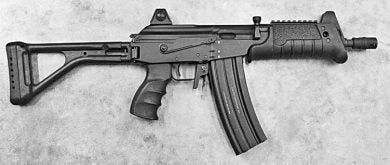
The selective-fire 5.56x45mm MAR which served as a basis for the semi-auto .30M1 Magal carbine.
With that in mind, IMI – Israel Military Industries (now, IWI – Israel Weapon Industries Ltd.) decided in the mid-to-late 1990s to use this round, both plenty available and liked, for a semi-auto derivative of the 5.56x45mm Micro Galil Assault Rifle, a.k.a. the MAR. The necessary internal design changes were added to the gas-operated Galil (this, in essence, widely based on the AK), this including not only a new 230mm-long barrel (five grooves, RH, 1:20 twist rate) but a number of alterations in the bolt/bolt carrier assembly and dimensional changes in the gas system to cope with the lower (as compared to the 5.56x45mm ammo) pressures generated by the .30M1 cartridge. While the original 30-round M1 Carbine magazine could be used, IMI also offered a fully-compatible 27-round unit which kept the bolt open after the last shot fired.
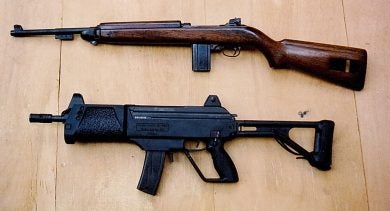
An M1 Carbine with a shorter 15-round magazine (2.6kg, loaded) and a Pará State Military Police Magal with the factory-supplied 27-round magazine (3.6kg, loaded).
Other than that, changes were mainly in the aesthetics/ergonomic department. The all-steel machined upper receiver and each part of the firing mechanism were housed within a one-piece polymer lower, which included the pistol grip, full hand size trigger guard, magazine housing and handguard, this featuring an orifice below the barrel for the addition of a flashlight. For the record, a fully disassembled Magal comprises 72 parts, field-stripping procedures being similar to that of the Galil family.
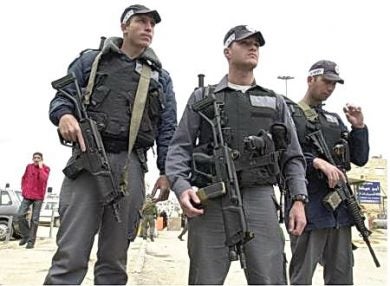
A couple of Magal carbines in the hands of Israeli Police agents, circa 2000, plus an M4-type gun by the side.
My old files tell me that an early batch of about 1,000 of those IMI carbines were delivered to police agencies for use in the 1999-2000 Israeli-Palestinian conflicts, but too many negative reports of their service use started coming back, including operating failures attributed to the very short barrel which produced insufficient gas pressure (worsened when riot control accessories were attached to the muzzle) and barrel overheating during continuous fire. The manufacturer was reported to have planned an initial production run of 4,000 guns, but I wonder if this was ever completed.

With the stock folded to the right, the Magal is 485mm long (740mm, full length). The weapon seen alongside with the stock extended is fitted with an add-on accessory on the muzzle for use with riot-control munitions.
However, the Magal was also promoted overseas. To my knowledge, the only confirmed export order came from Brazil’s PMPA – Polícia Militar do Pará (Pará State Military Police), which received 555 examples in 2001 or so. Note that the Magal had previously been tested, approved, and certificated (ReTEx No.1711/00, November 8, 2000) by the Brazilian Army prior to its adoption by PMPA. This scribe was lucky enough to have been invited to the city of Belém, Para State’s capital, for a quick hands-on encounter with the Israeli carbine at that time. Oh, yes: the Magal is still seen in occasional use today by the military cops of that Amazon region state.
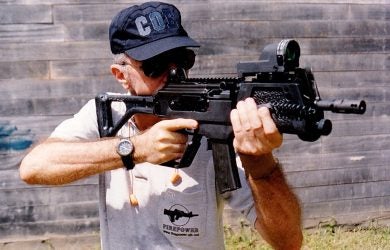
Author with a PMPA Magal during his visit to Belém, in the early 2000s. Gun is fitted with a Meprolight MEPRO 21-day/night illuminated reflex sight on the forward Picattiny mount, plus a flashlight in the handguard’s orifice. I don’t recall the sight having been, in fact, adopted by that military police agency.
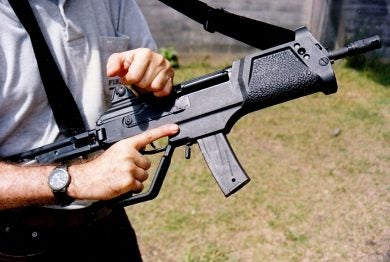
The charging handle on the right side is, however, easily manipulated with the left hand. The full-hand trigger guard and forward-pressing magazine catch are evident.


Top photo: the AK-type fire selector lever in the “Safe” position. Bottom photo: the duplicated selector on the left side, above de pistol grip, is now set for “Fire”.

The L-shaped flip aperture rear sight has settings for 150 (here) and 250 meters, featuring sturdy protection ears.
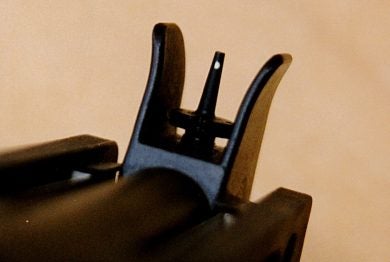
The front sight, equally well protected, has a small tritium insert to help in low-light situations.
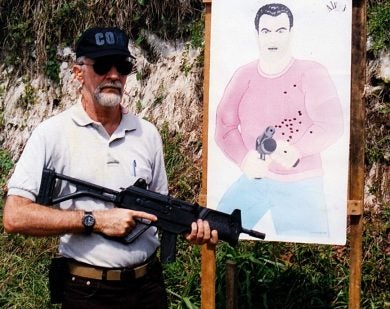
A few hundred rounds of jacketed soft-point rounds fired uneventfully in Belém gave me a general good feeling about the Magal, notwithstanding the reported problems in the text.

The business end of the little-known IMI Magal carbine in the hands of a Pará State Military Police agent. He is a member of the Motopatrulhamento (Motorcycle Patrolling) unit, one of the earlier local users of the Israeli gun.
Higher-res pics: https://imgur.com/a/kfyuA
 Your Privacy Choices
Your Privacy Choices
